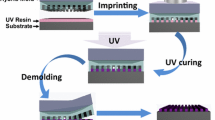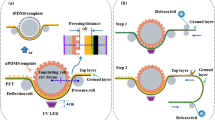Abstract
We invented a dual-curable transfer layer to enhance adhesion of the UV-curable nanoimprint resist to the substrate. Based on this transfer layer, we developed bilayer resist and trilayer resist UV-curable nanoimprint lithography processes, which were used for etching and lift-off processes, respectively. The dual-curable transfer layer combined at least two different types of reactive functions based on different polymerization mechanisms. It formed strong chemical bonds with both the underneath material and the nanoimprint resist layer in two curing steps. It helped improve the adhesion of the low surface energy resist film to the substrate substantially, and, more importantly, made high-resolution patterning much more reliable. Moreover, low aspect ratio imprinted patterns were amplified into high aspect ratio patterns through the transfer layer via a selective etching process.








Similar content being viewed by others
References
M.D. Austin, H.X. Ge, W. Wu, M.T. Li, Z.N. Yu, D. Wasserman, S.A. Lyon, S.Y. Chou, Fabrication of 5 nm linewidth and 14 nm pitch features by nanoimprint lithography. Appl. Phys. Lett. 84, 5299–5301 (2004)
M. Colburn, S. Johnson, M. Stewart, S. Damle, T. Bailey, B. Choi, M. Wedlake, T. Michaelson, S.V. Screenivasan, J. Ekerdt, C.G. Willson, Step and flash imprint lithography: a new approach to high-resolution patterning. Proc. SPIE 3676, 379–389 (1999)
J. Haisma, M. Verheijen, K. van den Heuvel, J. van den Berg, Mold-assisted nanolithography: a process for reliable pattern replication. J. Vac. Sci. Technol. B 14, 4124–4128 (1996)
J. Shaw, E. Babich, M. Hatzakis, J. Paraszczak, Polysiloxanes for optical lithography. Solid State Technol. 30, 83–89 (1987)
S.C. Johnson, T.C. Bailey, M.D. Dickey, B.J. Smith, E.K. Kim, A.T. Jamieson, N.A. Stacey, J.G. Ekerdt, C.G. Willson, D.P. Mancini, W.J. Dauksher, K.J. Nordquist, D.J. Resnick, Advances in step and flash imprint lithography. Proc. SPIE 5037, 197–202 (2003)
H.X. Ge, W. Wu, Z.Y. Li, G.Y. Jung, D.L. Olynick, Y.F. Chen, J.A. Liddle, S.Y. Wang, R.S. Williams, Cross-linked polymer replica of a nanoimprint mold at 30 nm half-pitch. Nano Lett. 5, 179–182 (2005)
C. Decker, K. Zahouily, A. Valet, Curing and photostabilization of thermoset and photoset acrylate polymers. Macromol. Mater. Eng. 286, 5–16 (2001)
K. Doren, W. Freitag, D. Stoye, Water-Borne Coatings: The Environmentally-Friendly Alternative (Hanser, New York, 1994)
A. El-ghayoury, C. Boukaftane, B. de Ruiter, R. van der Linde, Dual-cure processes: towards deformable crosslinked coatings. Macromol. Symp. 187, 553–561 (2002)
S. Peeters, In Overview of Dual-Cure and Hybrid-Cure Systems in Radiation Curing in Radiation Curing in Polymer Science and Technology, vol. III, ed. by J.P. Fouassier, J.F. Rabek (Elsevier Science, New York, 1993), pp. 177–218
K. Rainer, E. Beck, K. Menzel, Radiation-curable coating resins for outdoor use. Farbe Lack 105, 233–240 (1999)
W. Fischer, J. Weikard, Dual cure: new possibilities with radiation-curable coatings. Farbe Lack 107, 120–126 (2001)
J.F. Bohland, G.S. Calabrese, M.F. Cronin, D. Canistro, T.H. Fedynyshyn, J. Ferrari, A.A. Lamola, G.W. Orsula, E.K. Pavelchek, R. Sinta, J.W. Thackeray, A.K. Berry, L.E. Pogan Jr., M.P. de Grandpre, W.E. Feely, K.A. Graziano, R. Olsen, S. Thompson, M.R. Winkle, Some resists based on chemically-amplified crosslinking of phenolic polymers. J. Photopolym. Sci. Technol. 3, 355–373 (1990)
D.R. Bauer, G.F. Budde, Crosslinking kinetics and network formation in organic coatings containing hexamethoxymethylmelamine. J. Appl. Polym. Sci. 28, 253–266 (1983)
F.W. Billmeyer Jr., Textbook of Polymer Science, 3rd edn. (Wiley Interscience, New York, 1984)
E.W. Meijer, A model study for coatings containing hexamethoxymethylmelamine. J. Polym. Sci., A, Polym. Chem. 24, 2199–2208 (1986)
Y.J. Park, D.H. Lim, H.J. Kim, D.S. Park, I.K. Sung, UV- and thermal-curing behaviors of dual-curable adhesives based on epoxy acrylate oligomers. Int. J. Adhes. Adhes. 29, 710–717 (2009)
Acknowledgements
This work was jointly supported by the National Nature Science Foundation of China (Grant Nos. 10874072 and 91023014) and the National High Technology Research and Development Program of China (863 Program) (Grant No. 2007AA03Z334).
Author information
Authors and Affiliations
Corresponding authors
Rights and permissions
About this article
Cite this article
Xia, D., Ye, L., Guo, X. et al. A dual-curable transfer layer for adhesion enhancement of a multilayer UV-curable nanoimprint resist system. Appl. Phys. A 108, 1–6 (2012). https://doi.org/10.1007/s00339-012-6911-9
Received:
Accepted:
Published:
Issue Date:
DOI: https://doi.org/10.1007/s00339-012-6911-9




